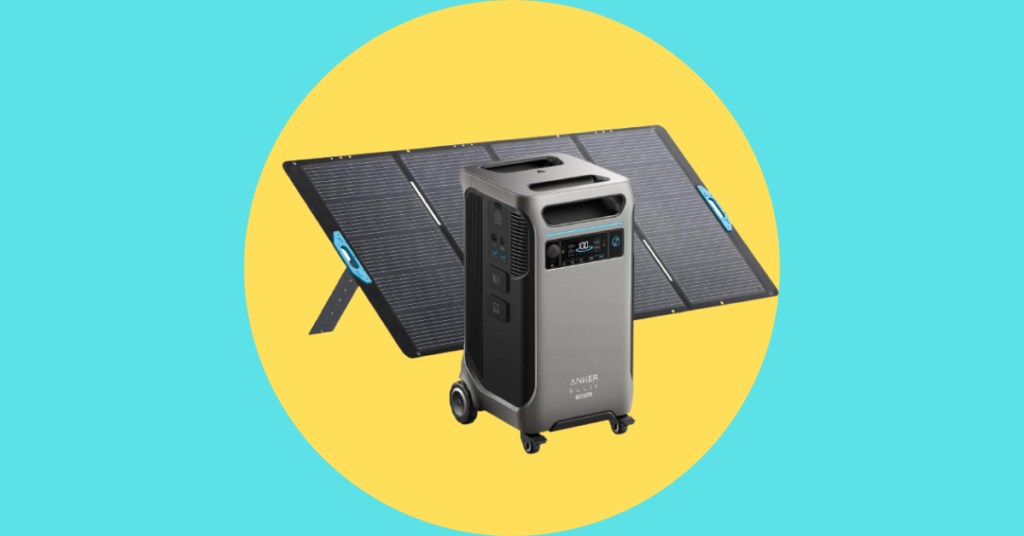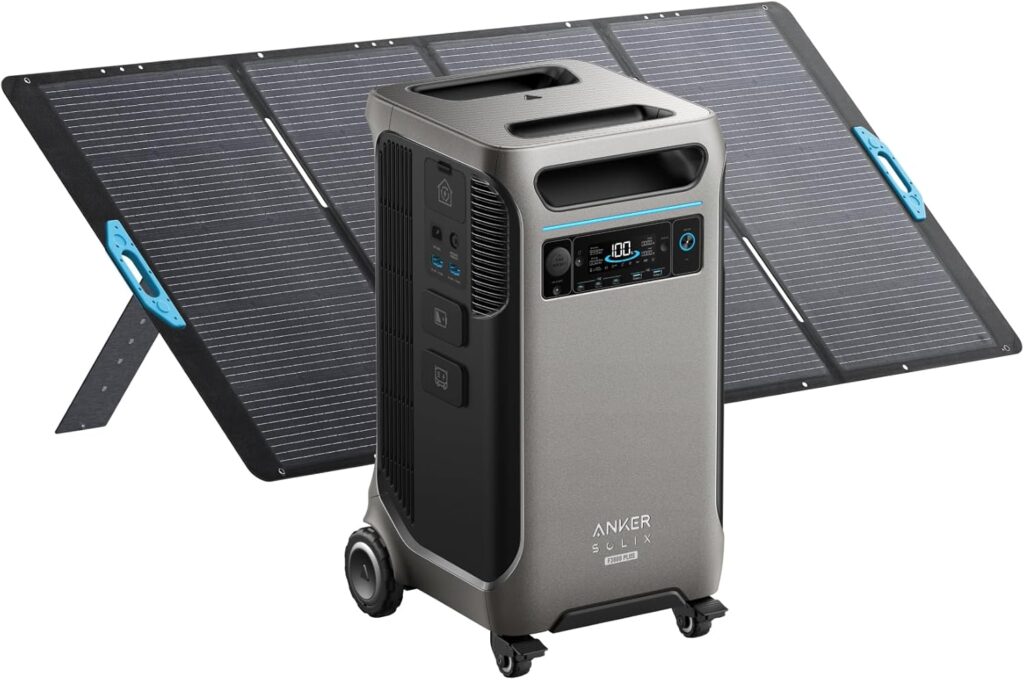Anker SOLIX F3800 Plus Portable Power Station: Full Review & Buyer’s Guide

“Proud Homemaker is part of several affiliate marketing programs, so we may earn commissions on products selected and purchased through our retailer links.”
Let me guess—you’ve been scrolling through power stations, comparing specs, and wondering if the Anker SOLIX F3800 Plus is actually worth the hype (and the investment). Same here. With more power outages, rising energy bills, and a growing interest in clean, off-grid living, I figured it was time to get serious about a reliable power solution.
So I took the plunge and tried out the Anker SOLIX F3800 Plus Portable Power Station, and in this post, I’m breaking down everything I’ve learned—the good, the not-so-good, and whether it’s truly worth your money.
Read also: Weber Genesis SX-335 Review: What You Need to Know Before You Buy
First Impressions: What Is the Anker SOLIX F3800 Plus?
Before getting into my experience, let’s get the basics out of the way.
The Anker SOLIX F3800 Plus is a high-capacity, dual-voltage portable power station designed for home backup, RV use, and even charging electric vehicles. It’s not your average “camping” power station—this thing is a serious piece of tech.
Here’s a quick look at what it offers:
- Base Capacity: Starts at 3.84 kWh—enough for a day’s worth of power for essential appliances.
- Expandable: Add up to 6 extra batteries (for a total of 26.9 kWh). Or go big with 12 batteries and another F3800 for up to weeks of backup power.
- Dual Voltage Output (120V/240V): Runs everything from your toaster to your dryer or well pump.
- Massive AC Output: 6,000W AC output, and up to 12,000W when paired with another unit.
- Solar + Generator Charging: 3,200W solar input + 240V gas generator compatibility (6,000W bypass).
- Remote Smart Control: Use the Anker app over Wi-Fi or Bluetooth to monitor, schedule, or control usage.
- EV + RV Compatible: Comes with NEMA L14-30 and TT-30P ports to plug straight into your electric vehicle or RV.
- Durability + Warranty: 10-year lifespan, 5-year warranty, and built with EV-grade LFP batteries.
Pretty impressive on paper, right? But here’s what it was like using it in real life.

Credit: Anker
Why I Chose the Anker SOLIX F3800 Plus Over Other Power Stations
I looked into EcoFlow, Bluetti, and Jackery before deciding. While many offer great features, the Anker SOLIX F3800 Plus stood out because of three main things:
- Dual-voltage output (a must for 240V appliances like my dryer and water heater).
- Unmatched expandability—26.9kWh with extra batteries, and more with dual units.
- EV + RV readiness—it felt like it could handle anything life throws at me.
I also trust Anker’s reputation for battery innovation, so that sealed the deal.
My Experience Using the Anker SOLIX F3800 Plus
When the box arrived (and yes, it’s heavy!), I immediately knew this wasn’t your run-of-the-mill portable power bank. This was serious equipment. Along with the main power station, I got two 400W solar panels, multiple charging cables, and the user manual—all neatly packed.
Setup
Setting it up was surprisingly easy. I placed it in my garage (because of the weight and ventilation) and connected the solar panels on a sunny afternoon. Within minutes, I could see everything on the Anker app—charging input, battery percentage, power usage by device. It honestly felt like I was running a mini power grid from my phone!
First Test: Powering the House
My first test run? A planned power outage in our area. I connected our fridge, microwave, Wi-Fi router, and even a portable AC—all running smoothly. The F3800 Plus didn’t even flinch. I even tried running our washing machine and vacuum cleaner simultaneously, and it held up.
Later, I connected my EV to test the direct charging via the NEMA port, and again, zero issues. It was seamless and way more efficient than I expected.
How It Handles Real-Life Emergencies
A few weeks in, a thunderstorm hit and knocked out power for nearly a day. I didn’t panic—I fired up the F3800 Plus. It powered my essential appliances, kept our phones charged, and even allowed my partner to work remotely without interruption. That moment alone justified the purchase for me.
Read also: Amazon Is Selling This Dreamy Two-Story Tiny House.
How Long Does It Take to Charge?
This depends on your input source:
- Using Solar (3,200W input): I fully recharged from 0% to 100% in about 3–4 hours on a clear, sunny day.
- Using a Gas Generator (240V bypass): Also took around 3 hours, depending on fuel and load.
- Wall Charging (standard outlet): Much slower—expect 7–8 hours.
Being able to combine both solar and gas inputs is a huge win when time is critical.
What Other Users Are Saying
While doing my research, I found hundreds of positive reviews online. People love its performance during emergencies, the reliable solar integration, and how quietly it runs compared to gas-only options. Many even use it daily to cut electricity bills by powering home appliances during peak hours.
Is It Good for Off-Grid Living or Just Emergencies?
Both! It’s built for more than just power outages. Whether you’re off-grid part-time in an RV or exploring full off-grid living, the Anker SOLIX F3800 Plus has the muscle and brains to support you. With the right solar setup and extra batteries, you can comfortably run essential devices and appliances for days.
What I Love About the Anker SOLIX F3800 Plus
Massive Expandability
The ability to scale up from 3.84 kWh to 26.9 kWh (or more) is a huge win. We live in an area that faces unpredictable storms, and knowing I can keep adding batteries for multi-day outages gives me serious peace of mind.
Solar & Generator Charging Combo
You don’t have to choose between solar and a generator—you can use both. On cloudy days, I plug in a small gas generator to keep the power going. The 3,200W solar input is more than enough on sunny days to fully charge it within hours.
Dual Voltage = No Limits
The 120V/240V output handled everything, from my kitchen appliances to my garage tools and electric car. That dual-voltage capability makes this truly a whole-home solution.
Smart App Control
I love being able to see what’s happening from my phone—how much solar is coming in, which devices are using the most power, and even switching modes from eco to performance mode. Total control in my hands.
Perfect for EVs and RVs
The built-in NEMA ports allow RV and EV use to be totally plug-and-play. If you’re on the road or living part-time in an RV, this could be a game-changer.
Build Quality & Longevity
Everything feels premium—from the sturdy casing to the touchscreen controls. With EV-class LFP batteries and a 10-year lifespan, I feel confident I won’t be replacing this anytime soon.
What I Don’t Love (But Can Live With)
No product is perfect, and there are a few things worth mentioning:
It’s Big and Heavy
At around 132 lbs, this isn’t something you just move around casually. You’ll want to set it up in one spot or invest in wheels or a cart if mobility matters.
Pricey Investment
It’s definitely an investment, especially if you start adding extra batteries or solar panels. But given the power, build quality, and features, I do think you’re getting value for money.
Noisy Fans Under Load
When running at full capacity, the cooling fans do kick in. It’s not super loud, but it’s noticeable—something to keep in mind if you plan to keep it inside your living space.
Read also: Everything You Need to Know About Breville The Grind Control Coffee Maker
Final Thoughts: Is the Anker SOLIX F3800 Plus Worth It?
Yes—if you need serious, reliable power, the Anker SOLIX F3800 Plus is 100% worth the investment. Whether you’re looking for a backup solution for your home, want to go partially off-grid, or need reliable power for your RV or EV setup, this power station delivers across the board.
The expandable capacity, solar and generator compatibility, dual voltage output, and intelligent controls make it one of the most capable power stations on the market today. It’s not cheap, and it’s not portable in the “carry-it-to-a-picnic” sense—but it was never meant to be.
For anyone looking to future-proof their home or travel setup, this is it.
Quick Specs Recap
- Base Capacity: 3.84kWh
- Max Expandable: 26.9kWh (with 6 batteries)
- AC Output: 6,000W (up to 12,000W with dual units)
- Solar Input: 3,200W
- Generator Bypass: 6,000W via 240V
- EV & RV Ready: Yes (NEMA L14-30, TT-30P)
- App Control: Yes (Wi-Fi/Bluetooth)
- Battery Type: EV-class LFP
- Lifespan: 10+ years
- Warranty: 5 years
Would I Recommend It?
Absolutely. If you’re on the fence and have the budget, the Anker SOLIX F3800 Plus will likely exceed your expectations. It’s powerful, smart, and built like a tank—everything I needed for peace of mind during blackouts and off-grid adventures.
Was this article helpful? We’d love to hear your feedback, ideas, or any blog post requests you have—drop them in the comments below!






